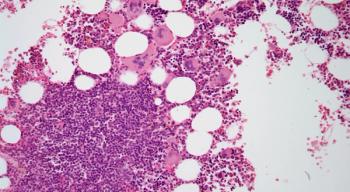
Revisiting the Role of Interferon Alfa-2 in the Treatment of Early Myelofibrosis
Is it time to revisit the therapeutic role of interferon alfa2 (IFN-α-2) in early myelofibrosis (MF) since new data show promising results? Silver et al from Weil-Cornell Medical College in New York has recently published the results of a prospective study, which used IFN-α-2 in the treatment of 17 patients with low and intermediate-1 risk categories, and >80% of patients showed either response or had stable disease with 2 patients achieving complete remission (CR), and seven partial remission (PR).
Is it time to revisit the therapeutic role of interferon alfa2 (IFN-α-2) in early myelofibrosis (MF) since new data show promising results?
Silver et al from Weill-Cornell Medical College in New York has recently published the results of a prospective study, which used IFN-α-2 in the treatment of 17 patients with low and intermediate-1 risk categories, and > 80% of patients showed either response or had stable disease with 2 patients achieving complete remission (CR), and seven partial remission (PR). Four patients had improvement in bone marrow morphology.[1]
Iannoto et al from the French Myelofibrosis Group published similar interesting results from a multicenter retrospective study using pegylated IFN-α-2 in the treatment of 18 MF patients and 89% showed response with 6 patients achieving CR.[2]
There are voices in the hemato-oncology community recommending IFN-α-2 to be considered as a first-line therapeutic intervention for primary MF in its hypercellular phase, post-essential thrombocythemia (ET) and post-polycythemia vera (PV).[3] However, the current guidelines on chronic myeloproliferative neoplasms (CMPNs) have not shown any signs of reconsidering their therapeutic attitude towards IFN-α-2,[4,5] despite a revival of IFN-α-2 in the management of CMPNs.[6,7]
References:
1. Silver RT, Vandris K, Goldman JJ. Recombinant interferon-{alpha} may retard progression of early primary myelofibrosis: a preliminary report. Blood. 2011;117: 6669–6672.
2. Ianotto JC, Kiladjiian JJ, Demroy JL, et al. PEG-INF-2a therapy in patients with myelofibrosis. A study of the French Groupe d’Etudes des Myelofibroses (GEM) and France Intergroupe des syndromes Myeloproliferatifs (FIM). Br J Haematol. 2009;146:218–230.
3. Hasselbalch HC, Kiladjian JJ, Silver RT. Interferon alfa in the treatment of Philadelphia-negative chronic myeloproliferative neoplasms. J Clin Oncol. 2011;29:e564–565.
4. Barbui T, Barosi G, Birgegard G, et al. Philadelphia-negative classical myeloproliferative neoplasms: Critical concepts and management recommendations from European eukemiaNet. J Clin Oncol. 2011; 29:761–770.
5. Tefferi A, Vainchenker W. Myeloproliferative neoplasms: Molecular pathophysiology, essential clinical understanding, and treatment strategies. J Clin Oncol. 2011;29:573–582.
6. Hasselbalch HC. Interferon alpha2 in the treatment of hematological malignancies. Status and perspectives. Curr Drug Targets. 2011;12:387–391.
7. Hasselbalch HC, Larsen TS, Riley CH, et al. Interferon-alpha in the treatment of Philadelphia-negative chronic myeloproliferative neoplasms. Status and perspectives. Curr Drug Targets. 2011;12:392–419.
Newsletter
Stay up to date on recent advances in the multidisciplinary approach to cancer.

















































































